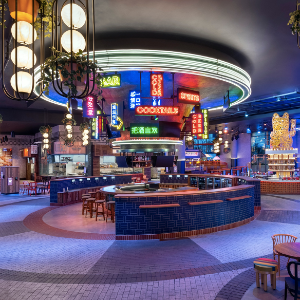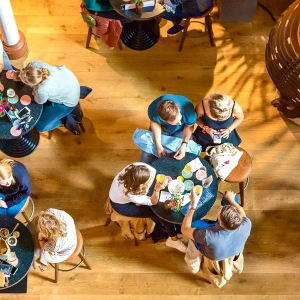 As the world moved online in the early months of 2020, so too did the manner in which we carried out our daily tasks. From technical issues that blighted even the most mundane of work tasks to companies being forced to move boundaries on things like a call ASA, there have been some huge shifts in how our workdays function.
As the world moved online in the early months of 2020, so too did the manner in which we carried out our daily tasks. From technical issues that blighted even the most mundane of work tasks to companies being forced to move boundaries on things like a call ASA, there have been some huge shifts in how our workdays function.
To have to turn your home into a makeshift gym, café, or hobby space for that thing you’d always wanted to learn, we’ve all had our fair share of “interesting” experiences with our fledgling, purely virtual existences.
The idea of this reality little more than 18 months ago would have struck most of us as the idea of hell on earth. The prospect of undertaking a holiday in this same isolated, reclusive way would have come across as about as foreign as the countries that we had previously planned to spend our time in.
Yet, here they are. Virtual holidays are a thing. As alien and as counterintuitive as it may seem, their reality has been cemented by a complete u-turn our lives have recently taken. How long they’ll be around is something that no one can really say. Taking advantage of them and their potential for money-making is something that all hotels, in particular, should be considering.
In this article, we’ll take a closer look at what virtual holidays are, how they work, and share some advice on how to go about producing one.
What Is Virtual Tourism?
As with your average eLearning course, the best place to start when it comes to discussing virtual holidays is at the beginning. So, before we take a look at how you can go about producing a virtual tourist experience, let’s make sure we’re all on the same page about what they are.
Virtual tourism, as an umbrella term, refers to the act of going on holiday whilst staying at home – it’ll make more sense shortly, just stick with it. At a time when crossing borders is as fraught with unknowns as it currently is, the safety and security of these experiences become appealing to prospective customers.
As a hotel operator, you have the chance to capitalize on this by producing content across a variety of technologies and formats that help to virtually transport your audience to a place that they will soon be able to experience for real.
The more immersive the technology through which they choose to experience these events, the more realistic the experience becomes. Not everyone has access to these cutting-edge virtual reality headsets, however, so ensuring your content can work across a multitude of platforms is key to creating an effective virtual tourist experience.
The Need of Virtual Holidays Beyond the Pandemic
When trying something new in business, you can’t simply cross your fingers and hope for the best. Being sure of the potential, both long and short term of a new offering is crucial in deciding on whether to go forward with it.
As vaccine rollouts across the globe continue, and citizens in the world’s wealthiest nations see the easing of restrictions on a one-way journey that will bring an end to the pandemic, the need for bringing about virtual experiences may now seem slightly odd.
Yet, putting in the groundwork now in setting up and trialing these experiences does come with a whole host of advantages. Should anything like this happen again and your clientele are prevented from booking a holiday with you, the lessons you learn and the mistakes you make from starting up virtual or augmented reality experiences now should not be ones that you later repeat. This allows you to hit the ground running in such a scenario.
Also, the virtual reality market is only going to grow over the coming years and decades. So, whilst the idea of a complete holiday in the virtual space may not be something people are enticed by, an element of virtual reality or virtual tourism, as part of a pre-booking “try before you buy” experience, could be a great asset for your hotel to have.
Regardless of how the need for virtual tourism changes in the future, there are some basics on how to go about producing these experiences which need to be understood. Throughout the rest of this article, we’ll share tips on how to create this content in a way that minimizes your potential mistakes and mishaps.
Equipment
You can have the most stunning location, the most unique architecture, even the most welcoming environment imaginable but If your virtual content looks shoddy, people aren’t going to enjoy it. So much of how we view the world nowadays relies on the quality of the equipment with which the images have been shot and the sound recorded.
It, as with any technology from streaming services to video conferencing equipment, isn’t always a case of the most expensive equipment equaling the best output. It’s more important to ensure your filming equipment is suitable for the kind of experience you’re looking to create.
If you want to produce something compatible with VR headsets, will your camera capture visuals that allow this? If you’re looking to take a series of still images, does your camera set-up produce the most impressive content possible? Will your camera produce video in 4K? Does your sound quality come across as clear and void of any distortion? These are the types of questions you need to ask yourself before plumping for the equipment you will use.
So, you have your equipment, and you’re set to record your content. Going ahead and shooting without planning can still produce the result you want, but planning out how you want the end product to look makes this more guaranteed.
Storyboarding can come to your rescue here. Visualizing how you want your final video, series of still images, or VR content to look is great in that it will help you make efficient decisions when it comes to shooting. If you’re working as part of a team, getting these visualizations down onto paper is an advisable way of planning out your content.
It ensures that everybody is on the same page, making disagreements less likely, and allowing you to get the content that you all want more productively.
Measure Twice, Cut Once
The phrase adjoined to this tip is more commonly associated with physical labor, such as woodworking. However, it can also be applied to the process of making your virtual tourism content, especially if you’re new to producing digital work and don’t have data-driven resources to reference.
The use of test shots is an ideal way of applying this discipline to your film or picture production. Taking these shots, which aren’t designed to be used in the final cut, allows you to make sure that the subject of your lens is set up in a manner that highlights the parts you want to amplify and takes focus away from the less desirable elements of your shot.
Taking a number of these can cause a shoot to last longer than it would otherwise be on set. However, they are a good way of avoiding any frustration in the latter stages of production. As any filmmaker will tell you, it’s best to spend a little more time on the shoot than you’d like if it means avoiding problems in the editing room further down the line.
Overshoot
As well as using test shots to ensure the final image or video that you produce looks exactly as you want it to, shooting more than you will ultimately require is also a good way of avoiding potential post-production obstacles.
If your video is designed to be five minutes long, don’t just shoot five minutes worth of content. Doing this would force you into using everything you have, regardless of its quality. If you shoot 30 minutes worth of content, this allows you more freedom to only include the best content you have available to you.
As long as you’re ruthless enough in the editing suite, this tactic will almost always deliver a better end product, whether it’s a virtual tourism video or part of an acceleration digital marketing campaign that VR may play a part in in the future.
The Devil is in the Detail
As with anything in business, from marketing to sales training technique, getting the broad strokes right is great. That said, elevating these through the smaller details like visual effects or the incorporation of product recommendations separates the excellent from the average.
Many of the details we are referring to here do not exist in the default content that you shoot. This consideration exists solely in the post-production world, but it can still be introduced in the planning stage.
Filters, sound effects, screen wipes, music, and any other nugget of production detail that can be used to enhance your basic content should all be considered. Knowing when to use them is as important as when to not, though, so don’t go overboard and sabotage the content by making it too artificial either.
Conclusion
It’s difficult to believe that this article would even have existed before COVID-19 took hold. The need for virtual holidays is still relatively new, so the time to make the mistakes is now.
Getting to a point where your business is proficient in the virtual world both safeguards you against any future pandemics and offers you a potential USP when it comes to booking conventional holidays in the future.
By following our tips above, you should be on the right path to creating effective virtual content that will be the envy of your rivals and a potential goldmine to boot.


















